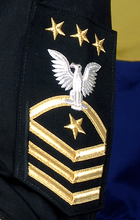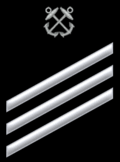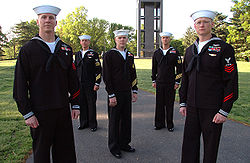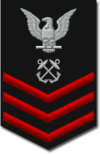
United States Navy enlisted rate insignia
Encyclopedia

United States Navy
The United States Navy is the naval warfare service branch of the United States Armed Forces and one of the seven uniformed services of the United States. The U.S. Navy is the largest in the world; its battle fleet tonnage is greater than that of the next 13 largest navies combined. The U.S...
enlisted rate indicates where an enlisted sailor stands within the chain of command, and also defines one's pay grade
Pay grade
Pay grades are used by the uniformed services of the United States to determine wages and benefits based on the corresponding military rank of a member of the services...
. An enlisted sailor's rate is similar conceptually to a naval officer's rank. The word rate refers to an enlisted sailor's pay grade, while the word rating refers to one's area of occupational specialization within the enlisted Navy. Associated with the enlisted pay grades is a numbering system from the most junior enlisted sailor ("E-1") to the most senior enlisted sailor ("E-9"). This enlisted numbering system is the same across all five branches of the U.S. Military
Military of the United States
The United States Armed Forces are the military forces of the United States. They consist of the Army, Navy, Marine Corps, Air Force, and Coast Guard.The United States has a strong tradition of civilian control of the military...
.
Ratings are earned through "A" schools, which are attended before deployment and after undergoing initial basic training at Recruit Training Command, Great Lakes, Illinois. Some members may undergo additional training in a "C" school either before or after a tour of duty. Upon completion, they are assigned a four-digit Navy Enlisted Classification
Navy Enlisted Classification
The Navy Enlisted Classification system supplements the rating designators for enlisted members of the United States Navy. A naval rating and NEC designator are similar to the Military Occupational Specialty designators used in the U.S. Army and U.S. Marine Corps and the Air Force Specialty Code ...
(NEC) code, which identifies a skill that is outside of their standard rating. An example is NEC 2780, which shows that the sailor is qualified as a Network Security Vulnerability Technician.
The rating symbols depicted for each rating badge listed below (except for the rating badge of the Command Master Chief) is Boatswain's Mate.
Uniforms

Those Petty Officers and above who meet good conduct requirements for twelve consecutive years are authorized to wear the gold variation
U.S. Navy Good Conduct Variation
In the United States Navy, enlisted members in pay grades E-4 to E-9 are authorized to wear gold rate insignia instead of red if the individual meets the requirements for good conduct service.-Gold Rating Badge and Service Stripes:...
s of their respective rating badges.
E-1 to E-3
Sailors in pay grades E-1 through E-3 are considered to be in apprenticeships.They are divided into five definable groups, with colored group rate marks designating the group to which they belong: Seaman, Fireman, Airman, Constructionman, and Hospitalman. One of three apprentice devices may be worn above the rank insignia, which denotes the sailor is an apprentice in a particular field and is in search of a rating to join. Sailors who have gone directly to a base, station, or ship without any specialized training are eligible to select a career field, and through correspondence courses
Distance education
Distance education or distance learning is a field of education that focuses on teaching methods and technology with the aim of delivering teaching, often on an individual basis, to students who are not physically present in a traditional educational setting such as a classroom...
and extensive on-the-job training, may qualify for a rating. This process is called "striking for a rate." If an enlisted member has qualified for a rate, but has not yet become a petty officer, he is called a designated striker, and is identified by a striker's badge that displays the sailor's rating, along with his group rate marks. The serviceperson is addressed by one's group designation, if known (e.g., Fireman Jones, Constructionman Apprentice Smith); by the generic appellation 'seaman'; or by one's striker designation (Boatswain's Mate Seaman Watson, Culinary Specialist Seaman Recruit Johnson).

| Sleeve insignia | Collar device | Rate title | Pay grade | Abbreviation | NATO code |
|---|---|---|---|---|---|
| No Insignia |
Seaman Recruit Seaman Recruit Seaman recruit is the lowest enlisted rank in the U.S. Navy and U.S. Coast Guard, just below seaman apprentice; this rank was formerly known as seaman third class... / Hospitalman Recruit |
E-1 | SR / HR | OR-1 | |
| No Insignia |
Fireman Recruit | E-1 | FR | OR-1 | |
| No Insignia |
Airman Recruit | E-1 | AR | OR-1 | |
| No Insignia |
Constructionman Recruit | E-1 | CR | OR-1 | |
 |
Seaman Apprentice Seaman Apprentice ConstructionmanvariationFiremanvariationAirmanvariationSeamaninsigniaSeaman apprentice is the second lowest enlisted rank in the U.S. Navy and U.S. Coast Guard, just above seaman recruit and below seaman; this rank was formerly known as seaman second class.The actual title for an E-2 in the U.S.... / Hospitalman Apprentice |
E-2 | SA / HA | OR-2 |
|-
|align="center"|

|align="center"|
|Fireman Apprentice
|align="center"|E-2
|align="center"|FA
|align="center"|OR-2
|-
|align="center"|

|align="center"|
|Airman Apprentice
|align="center"|E-2
|align="center"|AA
|align="center"|OR-2
|-
|align="center"|

|align="center"|
|Constructionman Apprentice
|align="center"|E-2
|align="center"|CA
|align="center"|OR-2
|-
|align="center"|

|align="center"|
|Seaman
Seaman
Seaman is one of the lowest ranks in a Navy. In the Commonwealth it is the lowest rank in the Navy, followed by Able Seaman and Leading Seaman, and followed by the Petty Officer ranks....
/ Hospitalman
|align="center"|E-3
|align="center"|SN / HN
|align="center"|OR-3
|-
|align="center"|

|align="center"|
|Fireman
|align="center"|E-3
|align="center"|FN
|align="center"|OR-3
|-
|align="center"|

|align="center"|
|Airman
|align="center"|E-3
|align="center"|AN
|align="center"|OR-3
|-
|align="center"|

|align="center"|
|Constructionman
|align="center"|E-3
|align="center"|CN
|align="center"|OR-3
|-
|}
E-4 to E-6

Non-commissioned officer
A non-commissioned officer , called a sub-officer in some countries, is a military officer who has not been given a commission...
s (NCOs), and are specifically called Petty Officer
Petty Officer
A petty officer is a non-commissioned officer in many navies and is given the NATO rank denotion OR-6. They are equal in rank to sergeant, British Army and Royal Air Force. A Petty Officer is superior in rank to Leading Rate and subordinate to Chief Petty Officer, in the case of the British Armed...
s in the Navy. Petty Officers perform not only the duties of their specific career field but also serve as leaders to junior enlisted personnel. They must take responsibility for their subordinates, address grievances, inform the chain of command
Chain of Command
Chain of Command may refer to:* Chain of command, in a military context, the line of authority and responsibility along which orders are passed* "Chain of Command" , the fifth episode of the first season of Beast Wars...
on matters pertaining to good order and discipline, and may even have to place personnel on report. The title Petty Officer comes from the French word petit, meaning something small. In medieval England
Britain in the Middle Ages
England in the Middle Ages concerns the history of England during the Medieval period — from the end of Roman rule in Britain through to the Early Modern period...
, villages had several "petite" or "petty" officers who were subordinate to major officials. Thus, Petty Officers are assistants to senior officers.
Petty Officers have been an important part of the U. S. Navy since its beginning. They were originally appointed by the ship's captain and usually held such appointments while serving under the captain who selected them. The Petty Officers of this time did not have uniforms or a rank insignia. In 1841 a rate badge was assigned, consisting of a sleeve device displaying an eagle perched on an anchor. Rating marks did not appear until 1866.
From 1885 to 1894, the Navy recognized three classes of Petty Officers—first, second, and third. These noncommissioned officers were authorized to wear a "rate" (rank) insignia consisting of chevrons
Chevron (insigne)
A chevron is an inverted V-shaped pattern. The word is usually used in reference to a kind of fret in architecture, or to a badge or insignia used in military or police uniforms to indicate rank or length of service, or in heraldry and the designs of flags .-Ancient history:The chevron occurs in...
pointing down under a spread eagle and a rating mark. Unlike the current rate badge, the eagle faced right instead of left. The current insignia for Petty Officers came about in 1894, and is a perched eagle with spread wings facing left (usually referred to as a "crow," due to its black color on white uniforms and the outdated dungaree working uniforms) atop a rating mark, with chevrons denoting their rank below.
The authority to wear gold rating badges and service stripes on the dress blue and working coverall uniform is granted when a sailor completes and maintains twelve consecutive years of honorable service without any official record of bad conduct due to punitive action via non-judicial punishment or courts martial
Courts-martial in the United States
Courts-martial in the United States are criminal trials conducted by the U.S. military. Most commonly, courts-martial are convened to try members of the U.S. military for violations of the Uniform Code of Military Justice , which is the U.S. military's criminal code...
. The gold rating badges and service stripes are distinct from the Good Conduct Medal
Good Conduct Medal
The Good Conduct Medal is one of the oldest military awards of the United States military. The Navy Good Conduct Medal was first issued in 1869, followed by a Marine version in 1896. The Coast Guard Good Conduct Medal was issued in 1923 and the Army Good Conduct Medal in 1941. The Air Force was...
, which is awarded for three years of honorable service.
Coloration of the insignia for E-4 through E-9 depends upon the uniform worn. Black cloth with red or gold embroidered stripes is used on the winter uniforms, while white cloth with black embroidered stripes is used on the summer uniforms, and medium blue cloth with red or gold embroidered stripes is used on the working coverall.
| Sleeve insignia | Collar device | Rate title | Pay grade | Abbreviation | NATO code | |
|---|---|---|---|---|---|---|
 |
 |
 |
Petty Officer Third Class Petty Officer Third Class U.S. NavyGood conductvariationU.S. NavyPetty officerthird classinsigniaPetty officer third class is the fourth enlisted rank in the U.S. Navy and U.S. Coast Guard, just above seaman and below petty officer second class, and is the lowest rank of non-commissioned officer, equivalent to a corporal in... |
E-4 | PO3 | OR-4 |
 |
 |
Petty Officer Second Class Petty Officer Second Class Good conductvariation,Petty OfficerSecond Classinsignia&U.S. Coast GuardPetty officer second class is the fifth enlisted rank in the U.S. Navy and U.S... |
E-5 | PO2 | OR-5 | |
 |
 |
Petty Officer First Class Petty Officer First Class Good conductvariation,12 years or moreof good conductPetty officerfirst classinsigniaU.S. Navy &U.S. Coast GuardPetty officer, first class is the sixth enlisted rank in the U.S. Navy and U.S... |
E-6 | PO1 | OR-6 | |
E-7 to E-9
E-7 to E-9 are still considered Petty Officers, but are considered a separate community within the Navy, unlike NCOs of other branches of service. They have separate berthing and dining facilities (where feasible), wear separate uniforms, and perform separate duties. Advancement to Chief Petty OfficerChief Petty Officer
A chief petty officer is a senior non-commissioned officer in many navies and coast guards.-Canada:"Chief Petty Officer" refers to two ranks in the Canadian Navy...
(E-7) or above requires a peer review by existing Chief Petty Officers beyond the normal examination score and performance evaluation process. The annual list of Chief selectees are authorized by Congress, leading chiefs to sometimes overstate, "it took an act of Congress to put these anchors here, it will take an act of Congress to take them off."
The proper form of address to a Chief Petty Officer is "Chief", "Senior Chief" (or "Senior"), or "Master Chief" according to their rating. In the U. S. Navy, the Chief is specifically tasked, in writing, with the duty of training Junior Officers (Ensign, Lieutenant (j.g.), Lieutenant, and Lieutenant Commander)—one of the major differences between a Chief in the Navy and his counterparts in the senior NCO corps in the Army, Marine Corps, and Air Force.
Although the title "Chief" has been around since the Continental Navy
Continental Navy
The Continental Navy was the navy of the United States during the American Revolutionary War, and was formed in 1775. Through the efforts of the Continental Navy's patron, John Adams and vigorous Congressional support in the face of stiff opposition, the fleet cumulatively became relatively...
in 1776, the Chief Petty Officer rate was not established until 1 April 1893. At that time nearly all enlisted members who had carried the rate of Petty Officer First Class since 1885 were advanced to Chief Petty Officer, with the exception of Schoolmasters, Ship's Writers, and Carpenter's Mates.
The rates Senior Chief
Senior Chief Petty Officer
U.S. Coast GuardSenior ChiefPetty Officercollar deviceU.S. Coast GuardSenior ChiefPetty OfficerinsigniaGood conductvariationSenior ChiefPetty OfficerinsigniaSenior ChiefPetty Officercollar device...
and Master Chief
Master Chief Petty Officer
- Master Chief Petty Officer :U.S. Coast GuardMaster ChiefPetty OfficerCap & Collar deviceU.S. Coast GuardMaster ChiefPetty OfficerinsigniaGood conductRating badgeMaster ChiefPetty OfficerCap & Collar Insignia...
were established on 1 June 1958. To be eligible for advancement to Senior Chief, a Chief Petty Officer must have had three years in the current grade. For advancement to Master Chief, a Senior Chief must have a total of three years in the current grade.
The dress blue insignia consists of a perched eagle or "crow" with spread wings atop a rating mark, with three chevrons and one 'rocker' above the rating mark. Inverted five-point stars above the crow denote the rank of Senior Chief (one star) or Master Chief (two stars). All other uniforms use the collar device to denote rank. It consists of a fouled anchor (an anchor that is entangled with its chain) with the initials U. S. N. (in silver) superimposed, with stars above the anchor to indicate higher pay grades, similar to the dress blue insignia.
| Sleeve insignia | Collar device | Rate title | Pay grade | Abbreviation | NATO code | |
|---|---|---|---|---|---|---|
 |
 |
 |
Chief Petty Officer Chief Petty Officer A chief petty officer is a senior non-commissioned officer in many navies and coast guards.-Canada:"Chief Petty Officer" refers to two ranks in the Canadian Navy... |
E-7 | CPO | OR-7 |
 |
 |
 |
Senior Chief Petty Officer Senior Chief Petty Officer U.S. Coast GuardSenior ChiefPetty Officercollar deviceU.S. Coast GuardSenior ChiefPetty OfficerinsigniaGood conductvariationSenior ChiefPetty OfficerinsigniaSenior ChiefPetty Officercollar device... |
E-8 | SCPO | OR-8 |
 |
 |
 |
Master Chief Petty Officer Master Chief Petty Officer - Master Chief Petty Officer :U.S. Coast GuardMaster ChiefPetty OfficerCap & Collar deviceU.S. Coast GuardMaster ChiefPetty OfficerinsigniaGood conductRating badgeMaster ChiefPetty OfficerCap & Collar Insignia... |
E-9 | MCPO | OR-9 |
Command Master Chief
After attaining the rank of Master Chief Petty Officer, servicemembers may choose to further their career by becoming a Command Master Chief Petty OfficerCommand Master Chief Petty Officer
-Background:First referenced in OPNAVINST 1306.2C dated 16 October 1995, the Navy's Command Master Chief Program is a valuable asset which stimulates free-flowing communications and ensures the highest standards of professionalism are upheld at all levels within the chain of command...
(CMC). A CMC is considered to be the senior-most enlisted service member within a command, and is the special assistant to the Commanding Officer
Commanding officer
The commanding officer is the officer in command of a military unit. Typically, the commanding officer has ultimate authority over the unit, and is usually given wide latitude to run the unit as he sees fit, within the bounds of military law...
in all matters pertaining to the health, welfare, job satisfaction, morale, utilization, advancement and training of the command's enlisted personnel. CMCs can be Command level (within a single unit, such as a ship or shore station), Fleet level (squadrons consisting of multiple operational units, headed by a flag officer or commodore), or Force level (consisting of a separate community within the Navy, such as Subsurface, Air, Reserves).
CMC insignia are similar to the insignia for Master Chief, except that the rating symbol is replaced by an inverted five-point star, reflecting a change in their rating from their previous rating (i.e., MMCM) to CMDCM. The stars for Command Master Chief are silver, while stars for Fleet or Force Master Chief are gold. Additionally, CMCs wear a badge, worn on their left breast pocket, denoting their title (Command/Fleet/Force).
| Sleeve insignia | Collar device | Rate title | Pay grade | Abbreviation | NATO code |
|---|---|---|---|---|---|
 |
Command Master Chief Petty Officer Command Master Chief Petty Officer -Background:First referenced in OPNAVINST 1306.2C dated 16 October 1995, the Navy's Command Master Chief Program is a valuable asset which stimulates free-flowing communications and ensures the highest standards of professionalism are upheld at all levels within the chain of command... |
E-9 | CMDCM | OR-9 | |
 |
Fleet/Force Master Chief Petty Officer | E-9 | FLTCM/FORCM | OR-9 |
Master Chief Petty Officer of the Navy
The Master Chief Petty Officer of the NavyMaster Chief Petty Officer of the Navy
The Master Chief Petty Officer of the Navy is a unique non-commissioned rank in the United States Navy, which has a paygrade of E-9. The holder of this rank and post is the most senior enlisted member of the U.S...
(MCPON) is the senior enlisted person in the Navy, appointed by the Chief of Naval Operations
Chief of Naval Operations
The Chief of Naval Operations is a statutory office held by a four-star admiral in the United States Navy, and is the most senior uniformed officer assigned to serve in the Department of the Navy. The office is a military adviser and deputy to the Secretary of the Navy...
(CNO) to serve as a spokesperson to address the issues of enlisted personnel to the highest positions in the Navy. The MCPON is the senior enlisted advisor to the Chief of Naval Operations
Chief of Naval Operations
The Chief of Naval Operations is a statutory office held by a four-star admiral in the United States Navy, and is the most senior uniformed officer assigned to serve in the Department of the Navy. The office is a military adviser and deputy to the Secretary of the Navy...
and Chief of Naval Personnel
Chief of Naval Personnel
The Chief of Naval Personnel is responsible for overall manpower readiness for the United States Navy. The CNP also serves as Deputy Chief of Naval Operations and is one of four Deputy Chiefs of Naval Operations, with the identification of N1/NT...
. Exact duties vary, depending on the CNO, though the duties generally include traveling throughout the Navy, observing training and talking to sailors and their families. The MCPON serves on several boards concerned with enlisted members, represents the Department of the Navy at special events, and may be called upon to testify before Congress regarding enlisted personnel issues.
The position was originally established as "Senior Enlisted Advisor of the Navy" in January 1967 in response to a recommendation from the Secretary of the Navy's task force on Navy personnel retention. Three months later, the title was officially changed to "Master Chief Petty Officer of the Navy". The individual rating specialty marks for the MCPON was replaced by an inverted star in 1971.
The MCPON's current insignia is similar to Fleet or Force CMCs, with the addition of a third star above the crow or anchor.
| Sleeve insignia | Collar device | Rate title | Pay grade | Abbreviation | NATO code |
|---|---|---|---|---|---|
 |
Master Chief Petty Officer of the Navy Master Chief Petty Officer of the Navy The Master Chief Petty Officer of the Navy is a unique non-commissioned rank in the United States Navy, which has a paygrade of E-9. The holder of this rank and post is the most senior enlisted member of the U.S... |
E-9 | MCPON | OR-9 |
See also
- List of United States Navy enlisted warfare designations
- List of United States Navy ratings
- Uniforms of the United States NavyUniforms of the United States NavyThis article examines dress uniforms, daily service uniforms, working uniforms, special situations, and the history of uniforms of the United States Navy...
- Badges of the United States NavyBadges of the United States NavyInsignia and badges of the United States Navy are military "badges" issued by the United States Department of the Navy to naval service members who achieve certain qualifications and accomplishments while serving on both active and reserve duty in the United States Navy...
- List of Naval Officer Designators
- United States Navy officer rank insigniaUnited States Navy officer rank insigniaIn the United States Navy, officers have various ranks. Equivalency between services is by pay grade.-Rank categories:In the U.S. Navy, pay grades for officers are:...
- List of United States Navy staff corps
- Military Occupational SpecialtyMilitary Occupational SpecialtyA United States military occupation code, or a Military Occupational Specialty code , is a nine character code used in the United States Army and United States Marines to identify a specific job. In the U.S. Air Force, a system of Air Force Specialty Codes is used...

